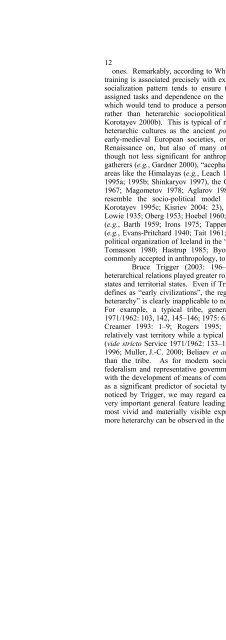Bondarenko Dmitri M. Homoarchy
Bondarenko Dmitri M. Homoarchy
Bondarenko Dmitri M. Homoarchy
Create successful ePaper yourself
Turn your PDF publications into a flip-book with our unique Google optimized e-Paper software.
12<br />
ones. Remarkably, according to Whiting and Childe (1953) the dependence<br />
training is associated precisely with extended families, whereas the respective<br />
socialization pattern tends to ensure the compliance in the performance of<br />
assigned tasks and dependence on the family, rather than reliance on oneself,<br />
which would tend to produce a personality type compatible with homoarchic<br />
rather than heterarchic sociopolitical systems (see also <strong>Bondarenko</strong> and<br />
Korotayev 2000b). This is typical of not only such paradigmatic examples of<br />
heterarchic cultures as the ancient polis and civitas, some late-ancient and<br />
early-medieval European societies, or Western countries from the time of<br />
Renaissance on, but also of many other cultures, probably less prominent<br />
though not less significant for anthropological theorizing: egalitarian huntergatherers<br />
(e.g., Gardner 2000), “acephalous complex societies” of mountainous<br />
areas like the Himalayas (e.g., Leach 1954; Fьrer-Haimendorf 1962; Berezkin<br />
1995a; 1995b; Shinkaryov 1997), the Caucasus (e.g., Khashaev 1961; Ikhilov<br />
1967; Magometov 1978; Aglarov 1988), etc., the most complex of which<br />
resemble the socio-political model of the Greek polis (Aglarov 1988;<br />
Korotayev 1995c; Kisriev 2004: 23), tribal societies of the Americas (e.g.,<br />
Lowie 1935; Oberg 1953; Hoebel 1960; Hickerson 1962; Harner 1972), Eurasia<br />
(e.g., Barth 1959; Irons 1975; Tapper 1983; Korotayev 1998b), and Africa<br />
(e.g., Evans-Pritchard 1940; Tait 1961; Hart 2000; Bonte 2004), or the sociopolitical<br />
organization of Iceland in the “Age of Democracy” (930 – 1267) (e.g.,<br />
Tomasson 1980; Hastrup 1985; Byock 1988) unclassifiable in categories<br />
commonly accepted in anthropology, to mention just a few.<br />
Bruce Trigger (2003: 196–197, 661, 665–666) postulates that<br />
heterarchical relations played greater role in small city-states than in larger citystates<br />
and territorial states. Even if Trigger is correct with respect to what he<br />
defines as “early civilizations”, the regularity “the smaller territory, the more<br />
heterarchy” is clearly inapplicable to non-state and modern industrial societies.<br />
For example, a typical tribe, generally heterarchic (vide stricto Service<br />
1971/1962: 103, 142, 145–146; 1975: 63–70; 1978b: 4–6; Fried 1975; Haas and<br />
Creamer 1993: 1–9; Rogers 1995; Southall 1996; Bonte 2000), covers<br />
relatively vast territory while a typical chiefdom is both generally homoarchic<br />
(vide stricto Service 1971/1962: 133–169; 1975: 15–16; 1978b: 6–8; Feinman<br />
1996; Muller, J.-C. 2000; Beliaev et al. 2001) and territorially more compact<br />
than the tribe. As for modern societies, the elaboration of principles of<br />
federalism and representative governmental bodies (local and national), joint<br />
with the development of means of communication eliminated the territory size<br />
as a significant predictor of societal type. However, in light of the tendency<br />
noticed by Trigger, we may regard early civilizations as cultures in which a<br />
very important general feature leading to heterarchy or homoarchy found the<br />
most vivid and materially visible expression. This feature is that normally<br />
more heterarchy can be observed in the societies in which interpersonal face-to-







